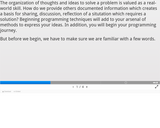
3 slide course presentation
- Subject:
- Applied Science
- Computer Science
- Material Type:
- Interactive
- Provider:
- Michigan Virtual
- Date Added:
- 12/11/2018

3 slide course presentation
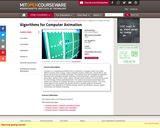
In-depth study of an active research topic in computer graphics. Topics change each term. Readings from the literature, student presentations, short assignments, and a programming project. Animation is a compelling and effective form of expression; it engages viewers and makes difficult concepts easier to grasp. Today's animation industry creates films, special effects, and games with stunning visual detail and quality. This graduate class will investigate the algorithms that make these animations possible: keyframing, inverse kinematics, physical simulation, optimization, optimal control, motion capture, and data-driven methods. Our study will also reveal the shortcomings of these sophisticated tools. The students will propose improvements and explore new methods for computer animation in semester-long research projects. The course should appeal to both students with general interest in computer graphics and students interested in new applications of machine learning, robotics, biomechanics, physics, applied mathematics and scientific computing.
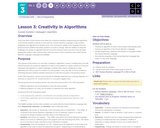
This is the third of three lessons that make the connection between programming and algorithms. In this lesson students continue to work with the "Human Machine Language" to get creative designing more algorithms for playing cards. One command is added to the language from the previous lesson (SWAP) that allows positions of cards to change. With the addition of swap the challenge is to design an algorithm that will move the minimum card to the front of the list while keeping the relative order of all the other cards the same. If that is achieved some other Human Machine Language challenges are available.
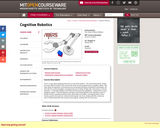
This is a class about applying autonomy to real-world systems. The overarching theme uniting the many different topics in this course will center around programming a cognitive robotic. This class takes the approach of introducing new reasoning techniques and ideas incrementally. We start with the current paradigm of programming you're likely familiar with, and evolve it over the semester—continually adding in new features and reasoning capabilities—ending with a robust, intelligent system. These techniques and topics will include algorithms for allowing a robot to: Monitor itself for potential problems (both observable and hidden), scheduling tasks in time, coming up with novel plans to achieve desired goals over time, dealing with the continuous world, collaborating with other (autonomous) agents, dealing with risk, and more.

Introduction to computer graphics hardware, algorithms, and software. Topics include: line generators, affine transformations, line and polygon clipping, splines, interactive techniques, perspective projection, solid modeling, hidden surface algorithms, lighting models, shading, and animation. Substantial programming experience required. 6.837 offers an introduction to computer graphics hardware, algorithms, and software. Topics include: line generators, affine transformations, line and polygon clipping, splines, interactive techniques, perspective projection, solid modeling, hidden surface algorithms, lighting models, shading, and animation. Substantial programming experience is required.
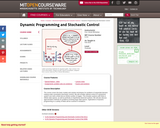
The course covers the basic models and solution techniques for problems of sequential decision making under uncertainty (stochastic control). We will consider optimal control of a dynamical system over both a finite and an infinite number of stages. This includes systems with finite or infinite state spaces, as well as perfectly or imperfectly observed systems. We will also discuss approximation methods for problems involving large state spaces. Applications of dynamic programming in a variety of fields will be covered in recitations.
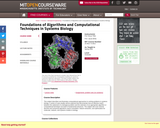
This subject describes and illustrates computational approaches to solving problems in systems biology. A series of case-studies will be explored that demonstrate how an effective match between the statement of a biological problem and the selection of an appropriate algorithm or computational technique can lead to fundamental advances. The subject will cover several discrete and numerical algorithms used in simulation, feature extraction, and optimization for molecular, network, and systems models in biology.

In this 25-day module of Grade 4, students extend their work with whole numbers. They begin with large numbers using familiar units (hundreds and thousands) and develop their understanding of millions by building knowledge of the pattern of times ten in the base ten system on the place value chart (4.NBT.1). They recognize that each sequence of three digits is read as hundreds, tens, and ones followed by the naming of the corresponding base thousand unit (thousand, million, billion).
Find the rest of the EngageNY Mathematics resources at https://archive.org/details/engageny-mathematics.
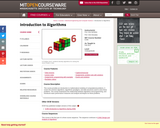
This course provides an introduction to mathematical modeling of computational problems. It covers the common algorithms, algorithmic paradigms, and data structures used to solve these problems. The course emphasizes the relationship between algorithms and programming, and introduces basic performance measures and analysis techniques for these problems.

(Nota: Esta es una traducción de un recurso educativo abierto creado por el Departamento de Educación del Estado de Nueva York (NYSED) como parte del proyecto "EngageNY" en 2013. Aunque el recurso real fue traducido por personas, la siguiente descripción se tradujo del inglés original usando Google Translate para ayudar a los usuarios potenciales a decidir si se adapta a sus necesidades y puede contener errores gramaticales o lingüísticos. La descripción original en inglés también se proporciona a continuación.)
En este módulo de 25 días de grado 4, los estudiantes extienden su trabajo con números enteros. Comienzan con grandes números utilizando unidades familiares (cientos y miles) y desarrollan su comprensión de millones al desarrollar el conocimiento del patrón de tiempos diez en el sistema Base Ten en la tabla de valor del lugar (4.nbt.1). Reconocen que cada secuencia de tres dígitos se lee como cientos, decenas y, seguidas de la denominación de la base correspondiente, mil unidad (mil, millones, mil millones).
Encuentre el resto de los recursos matemáticos de Engageny en https://archive.org/details/engageny-mathematics.
English Description:
In this 25-day module of Grade 4, students extend their work with whole numbers. They begin with large numbers using familiar units (hundreds and thousands) and develop their understanding of millions by building knowledge of the pattern of times ten in the base ten system on the place value chart (4.NBT.1). They recognize that each sequence of three digits is read as hundreds, tens, and ones followed by the naming of the corresponding base thousand unit (thousand, million, billion).
Find the rest of the EngageNY Mathematics resources at https://archive.org/details/engageny-mathematics.
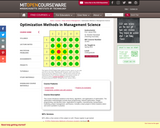
Introduces students to the theory, algorithms, and applications of optimization. The optimization methodologies include linear programming, network optimization, dynamic programming, integer programming, non-linear programming, and heuristics. Applications to logistics, manufacturing, transportation, E-commerce, project management, and finance.
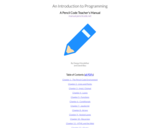
In this manual we will show how to use Pencil Code to explore programming. Pencil Code is a free programming tool available at pencilcode.net. Pencil Code was developed by Google engineer David Bau together with his son Anthony Bau, with open-source contributions from many others.
This manual is intended for a high school, an introduction to programming course. Students 9th, 10th and possibly 11th graders would benefit from taking this course. An advanced 8th grade student could take this. A typical math pre-requisite of pre-algebra would be sufficient to take this course.
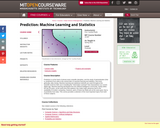
Prediction is at the heart of almost every scientific discipline, and the study of generalization (that is, prediction) from data is the central topic of machine learning and statistics, and more generally, data mining. Machine learning and statistical methods are used throughout the scientific world for their use in handling the "information overload" that characterizes our current digital age. Machine learning developed from the artificial intelligence community, mainly within the last 30 years, at the same time that statistics has made major advances due to the availability of modern computing. However, parts of these two fields aim at the same goal, that is, of prediction from data. This course provides a selection of the most important topics from both of these subjects.

This lesson was remixed from a lesson on code.org: Graph Paper ProgrammingThis resource was remixed to become an unplugged (no device needed) activity that can be done with adults and students to learn how to develop an algorithm and encode it into a program.The goal of this activity is to build critical thinking skills and excitement for the computer science.
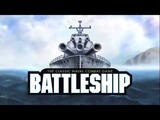
Computers are often required to find information in large collections of data. They need to develop quick and efficient ways of doing this. This activity demonstrates three different search methods: linear searching, binary searching and hashing.
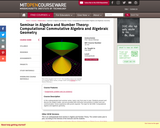
In this undergraduate level seminar series topics vary from year to year. Students present and discuss the subject matter, and are provided with instruction and practice in written and oral communication. Some experience with proofs required. The topic for fall 2008: Computational algebra and algebraic geometry.
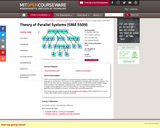
6.895 covers theoretical foundations of general-purpose parallel computing systems, from languages to architecture. The focus is on the algorithmic underpinnings of parallel systems. The topics for the class will vary depending on student interest, but will likely include multithreading, synchronization, race detection, load balancing, memory consistency, routing networks, message-routing algorithms, and VLSI layout theory. The class will emphasize randomized algorithms and probabilistic analysis, including high-probability arguments.

This video lesson will introduce students to algorithmic thinking through the use of a popular field in graph theory—social networking. Specifically, by acting as nodes in a graph (i.e. people in a social network), the students will experientially gain an understanding of graph theory terminology and distance in a graph (i.e. number of introductions required to meet a target person). Once the idea of distance in a graph has been built, the students will discover Dijkstra's Algorithm. The lesson should take approximately 90 minutes and can be comfortably partitioned across two class sessions if necessary (see the note in the accompanying Teacher Guide). There are no special supplies needed for this class and all necessary hand-outs can be downloaded from this website.

This video lesson will introduce students to algorithmic thinking through the use of a popular field in graph theory—social networking. Specifically, by acting as nodes in a graph (i.e. people in a social network), the students will experientially gain an understanding of graph theory terminology and distance in a graph (i.e. number of introductions required to meet a target person). Once the idea of distance in a graph has been built, the students will discover Dijkstra's Algorithm. The lesson should take approximately 90 minutes and can be comfortably partitioned across two class sessions if necessary (see the note in the accompanying Teacher Guide). There are no special supplies needed for this class and all necessary hand-outs can be downloaded from this website.